Before and after photos on porcelain metal bridge problems or crown complications performed in our Cosmetic Dentistry office.
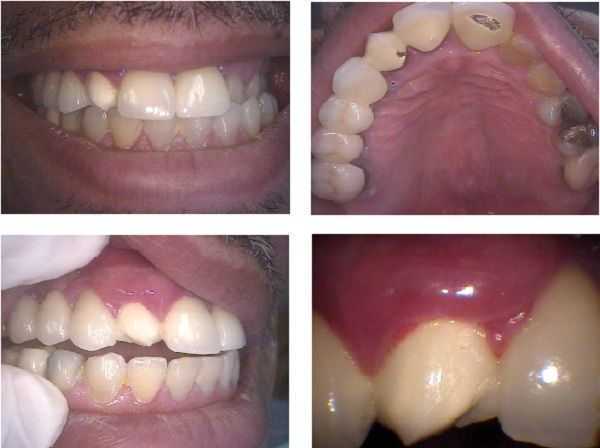
This patient came in with porcelain broken off the lateral tooth of a six tooth fixed porcelain and metal bridge. Prior history: He said that two months earlier this six year old bridge had fallen out and his current dentist refused to recement it. His dentist refused to recement the bridge because the teeth underneath had cavities and he needed dental implants instead. The patient then found another dentist who agreed to recement this bridge. The patient did not bring x-rays and refused to have them taken. A clinical exam revealed significant periodontal inflammation and hypertrophy around the lateral and central incisors. This patient was not a candidate for the 3/4 crown repair procedure shown in the next example. He returned to his current dentist. Repairing broken porcelain on a large bridge should only be undertaken if the bridge and teeth underneath are in good health.
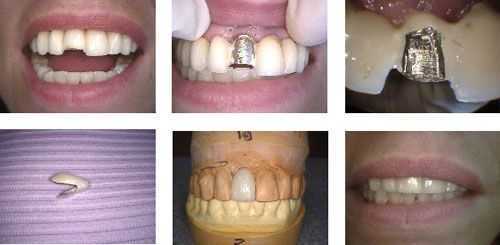
Sometimes a patient will break the porcelain on one dental crown that is part of a large fixed dental porcelain metal bridge – caps. A dentist should not need to replace an entire bridge that could involve 12 teeth just to fix one. These pictures show how to repair broken porcelain on a dental crown that is part of a 12 teeth bridge. Fabricate a 3/4 dental crown to fit over the metal frame of the 12 teeth fixed porcelain metal dental bridge. Use dental cement to attach it.

Endodontic (root canal) retreatment of tooth #29 and treatment of #28. The five-unit dental bridge had cement leakage and the teeth abutments decayed after only 1 and 1/2 years. The patient said that #29 was always sensitive after the original root canal was performed by her then general dentist. Retreatment of #29 by an endodontist (root canal specialist)revealed a second, previously undiagnosed and untreated second canal. A post space was created in this second canal after obturation.
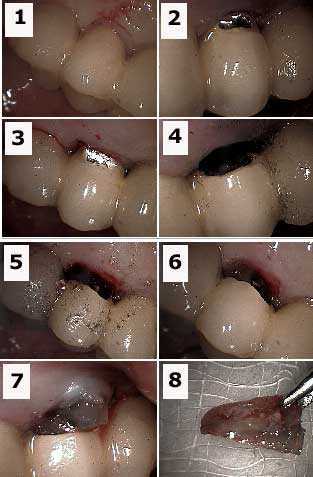
Technique for root resection from under a porcelain fused to metal dental bridge. How to pictures. 1) Labial photo of an abutment with an endodontic – periodontal lesion. 2) & 3) Initial preparation into porcelain with a diamond bur. 4) Labial photo showing preparation. The metal portion of the bridge is prepared with a steel bur. 5) Palatal photo showing preparation. 6) Labial photo showing the tooth root under the porcelain (gutta percha is visible in the tooth root). 7) Tooth root being extracted. The occlusal height of this root must first be reduced to allow it to exit. 8) The extracted tooth root.
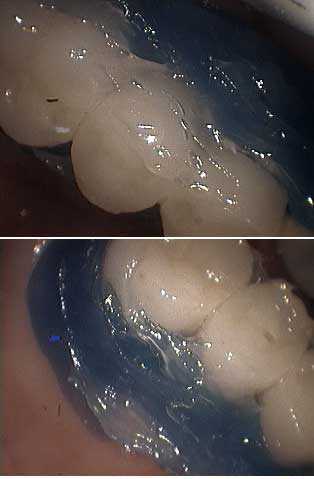
A helpful tip for taking an impression that includes a fixed dental crown or bridge. Place blue periphery wax and Vaseline to prevent the impression material from locking into the undercuts in the pontics or embrasures.

Tooth root resection from under a porcelain fused to metal dental bridge. 1) X-ray showing the distal abutment with an endo-perio lesion. 2) Labial photo of the same tooth. 3) Xray following resection (the metal chad in the area of the extracted abutment was later removed). 4) Labial photo following extraction. This area could be filled in with bonding after healing. The occlusion on the distal cantilever was reduced. It opposed a lower full arch bridge so that supra-eruption was not a concern. Treatment options include: i) sectioning and removal of the distal cantilever, ii) implants, or iii) reevaluate over time with the patient informed to reduce function in this area.
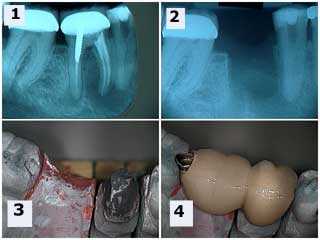
Two-unit dental bridge with an occlusal rest seats onto the rest preparation in the mesial of the second molar crown. This eliminates the need for removing the second molar crown. The premolar tooth did receive root canal therapy, endodontics, following healing of the extraction site.

Cervical decay – root surface cavity – and root canal infection around a lower right first premolar tooth. 1) A large radiolucency is seen in the x-ray. Note the distal abutment is the distal root of a first molar following hemisection. 2) Following root canal therapy. The cervical decay can now be seen more easily. 3) The working model showing the preparation of the mesial part of the distal two-unit bridge. This preparation will allow rigid connection to the new anterior bridge being made. 4) The new bridge section in place on the working model. 5) & 6) Two photos of the new bridge showing the distal attachment. 7) An intra oral view which mirrors the working model view seen in 3). 8) The final result. This patient was content to see the gold occlusal rest. Otherwise, it could have been hidden under porcelain.

Trauma to a lower left dental bridge following an accident. 1) The initial x-ray showing the three-unit bridge and severe damage to the second premolar tooth. 2) The second molar tooth showing a furcation involvement and thickening of the periodontal ligament space – PDL – around the mesial root. The second premolar and the mesial root of the second molar were extracted. 3) Intra oral photo following healing. The patient was informed regarding the long span and declined dental implants. He wanted a new fixed bridge anyway. 4) X-ray healing of the distal root of the second molar after six weeks. The lesson here is the value of salvaging individual roots of molar teeth.
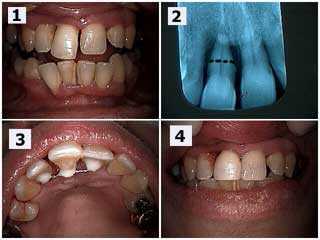
The patient’s chief complaint was that the upper right central incisor tooth (#8) was very loose and she did not want to lose the tooth. 1) Upper right central incisor (#8) has extruded and moved labially (toward the lip) and a diastema (space) has occurred. 2) X-ray showing severe bone loss. The black dotted line shows the location for a potential root resection if necessary. Root planing was performed after the splint was placed and the patient will return in three months to reevaluate periodontal healing and the potential need for the root resection. 3) Palatal photo of the splint between teeth #’s 7 – 9. 4) Post-op photo. Same day. Notice the diastema (space) was closed with dental bonding to hide the splint and the incisal edge of #8 was reduced.
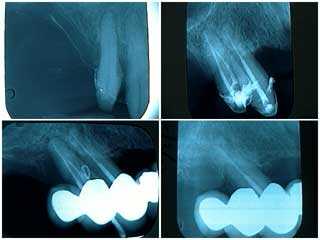
X-ray series of a failing distal abutment tooth in a one year old reconstruction. 1) Pre-operative. 2) Following root canal therapy, root planing and open debridement. 3) Gutta percha placed into a periodontal abscess one year later. 4) Following root planing, targeted antibiotics and extraction. The roots of this extracted tooth were fused. This patient was scheduled for a three month recall; she did not return for eight months following her first three month recall visit. The periodontal abscess was readily apparent at this time. It is suggested that reconstruction patients are treated, not cured, and that they must be closely supervised. Patients need to be acutely aware of the need for frequent recall visits. It is possible that earlier diagnosis and intervention might have prevented the loss of this tooth.
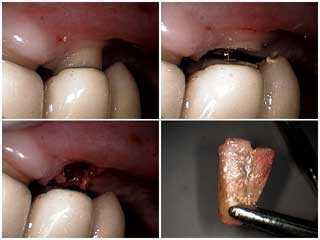
Technique for removal of a failing distal abutment tooth under a fixed, porcelain ten dental crown bridge reconstruction. How to pictures. 1) Upper first premolar with probing to the apex. 2) Horizontal sectioning through tooth to separate it from the bridge. You need to reduce enough of the remaining tooth root to elevate it while under the bridge. 3) Tooth socket after tooth removal. 4) Extracted tooth root. The gingival surface of the newly created pontic could be bonded after primary healing has occurred.

Cement wash out – leakage – under an old dental bridge. Dentists should always check for this during routine check up exams. Try to lift a bridge in an occlusal direction with gentle fingertip force and then push the bridge in a gingival direction. Air bubbles should not be seen around the dental crown margins with this gentle up and down motion or it could indicate cement leakage. How to diagnose cement leakage around dental crowns. Pictures.
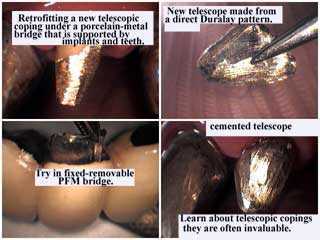
Retrofitting a new telescopic coping under a porcelain-metal dental bridge that is supported by dental implants and teeth. How to photos.
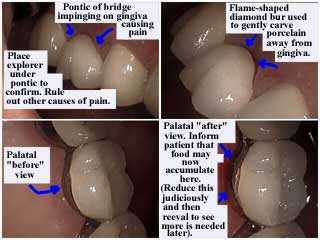
Pontic of dental bridge was impinging on the gingiva causing pain. How to technique to relieve stress on the gums is seen in the pictures.
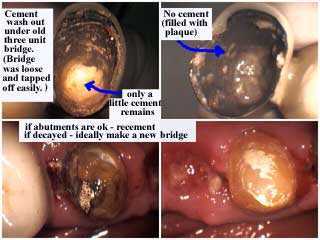
Cement wash out, leakage, under an old three unit teeth bridge.
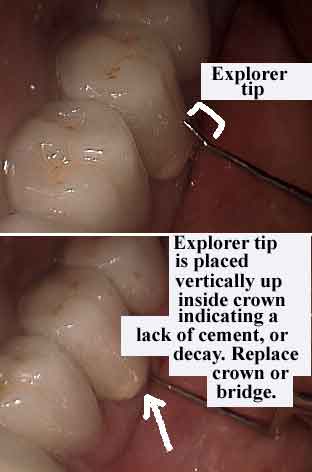
ALWAYS check cement seals of fixed dental bridgework during exams. A dental explorer should not be able to fit underneath the dental crown margin.
Try to lift a bridge in an occlusal direction with gentle fingertip force and then push the bridge in a gingival direction. Air bubbles should not be seen around the dental crown margins with this gentle up and down motion or it could indicate cement leakage. How to diagnose cement leakage around dental crowns bridge.
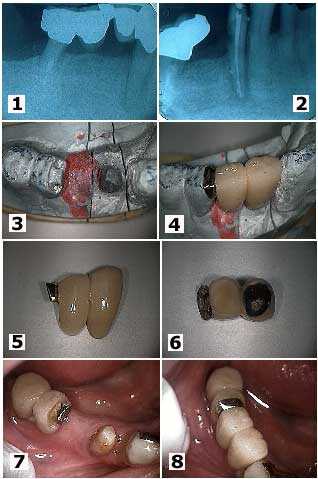
Attaching a porcelain-metal teeth bridge to another porcelain-metal teeth bridge in the middle of a pontic. 1) This elderly patient developed distal root caries under a dental bridge and a root canal infection on a lower first premolar tooth. Note in the x-ray that the distal molar had previously been hemisected. 2) X-ray following bridge section removal and root canal therapy. 3) – 4) Photos show two and a half unit dental bridge fabricated and seated on the working model. 5) – 6) Two pictures of the two and a half unit bridge. The distal half unit has been fabricated with a female semi-precision attachment. 7) Intra oral photo. Note how the metal framework of the pontic was prepared into a “T” shape to help lock in the bridge upon cementation. 8) The final bridge.
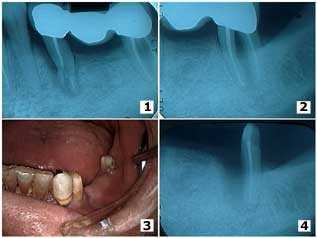
Trauma from a fall in an elderly male resulted in root fracture of the mesial abutment of a three-unit dental bridge and a furcation involvement in the distal molar abutment. 1) – 2) The pre-operative x-rays. 3) The second premolar tooth was extracted and the first premolar was used as the mesial abutment of a new four-unit dental bridge. 4) The second molar was hemisected because of deep probing depths around the mesial root and the mesial root was extracted. The distal root was used as the distal abutment of the new bridge. Bone fill can be seen around the mesial surface of the distal root; a cribriform plate and periodontal ligament space can be seen developing.
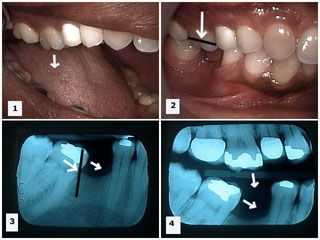
Supraeruption and mesial drift secondary to extraction of a lower first molar tooth. 1) -2) Photos showing the upper first molar has supra-erupted because its opposing antagonist, the lower first molar, has been removed – extracted. 3) X-ray shows mesial drift of the lower second molar tooth is secondary to the removal of the lower first molar. 4) Both supraeruption of the upper first molar and mesial drifting of the lower second molar can be seen in this one x-ray secondary to the removal of the lower first molar. Conclusion: tooth extraction can frequently cause significant occlusal – bite – problems if not actively prevented.
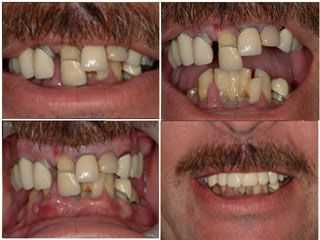
Oral Reconstruction performed by a Columbia University dental student in our office. The student, Jared Bowyer, is part of a unique honors program at Columbia.
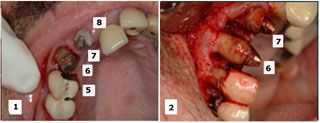
Selective teeth extraction during an upper oral reconstruction. The initial treatment plan considered saving #’s 6, 7 and 9 while extracting #’s 5 and 8. During the surgery, #5 was considered more stable than #6 so #5 was retained and #6 was extracted. The retained teeth will be used to support a fixed temporary dental bridge until subsequent implant dentistry is completed. This reconstruction is being performed in our office by Jared Bowyer, a Columbia University dental student, who is part of a unique honors program. The surgery was performed by oral surgeon, Reza Miremadi, D.D.S, M.D.